Warning: this article is full of generalizations which
may or may not accurately reflect the people of India or
their film industry. In addition, when I wrote this originally, Bollywood
films were largely unknown to mainstream American
filmgoers, but with the success of Slumdog Millionaire,
pretty much everybody knows about them now.
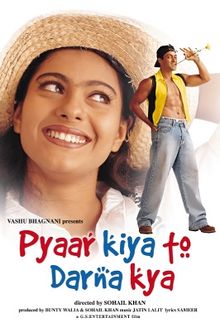
When I tell people that I like Indian movies, the most
common response is, "you mean, like, from India?" Had these
people any concept of the huge film industry of Bombay, they
would feel foolish for assuming I might be talking about
Native Americans.
India has had a thriving film industry since the first
feature-length silent film was produced in 1913. The people
of India have always been deeply affected by cinematic
images. Early films which portrayed religious stories often
caused people to genuflect to the life-like images of gods
on the screen. They would avert their eyes and fall to the
floor in fervent prayer when suddenly confronted with
figures which had only previously been paintings on the
walls of shrines. Although the Indian film industry has a
history of great cinematic works which some claim rivals
that of the French, it was the big-budget musical
extravaganza craze of the 1960s that helped Indian movies
find their niche. According to one website,
India is the largest producer of films in the world.
"Bollywood," as it is known (the name is a hybrid of
"Bombay" and a California town you probably have never heard
of), has millions of fanatical fans around the world,
innumerable superstars and sex symbols, and is busy cranking
out loads of movies at any given time. Virtually all of these films are escapist
musicals, which incorporate a variety of elements to make
them appeal to a broad audience. My intense distaste for
most English-language musicals is perhaps what makes Indian
musicals so appealing... it's almost as if they're a parody
of American musicals because the productions are so
incredibly outrageous. The intense competition for the box
office rupee has led to increasingly elaborate musical
sequences, usually involving bizarre locations (on top of a
moving train, in an airplane that seems to be crashing, in
the middle of Times Square in New York City) and hundreds of
singers and dancers, all pantomiming to songs which were
obviously sung by professional vocalists in a distant
recording studio. The music is fantastic, usually an
ultra-catchy hybrid of traditional Indian instruments and
hip-hop or tribal rhythms, sometimes incorporating parodies
of popular songs like "The Macarena," or sometimes featuring
rapping in Hindi. In addition, since I can't understand the
language, I try to imagine that they are singing something
intelligent while dancing around in the crashing
airplane.
it's almost as if they're a parody
of American musicals because the productions are so
incredibly outrageous.
There are some considerations for the casual non-Indian
viewer. First, it's rare to see English subtitles in a
Bollywood film. The movies are so broad that it's not too
hard to figure out what's going on, but often times it's
kind of confusing. Another consideration for people with
short attention spans is that the films are very long. Every
movie we've seen clocks in at over three hours. There are
two reasons for this: 1. they are pure escapism, so the
longer you can get away from your life, the better; and 2.
they try to include everything they can to make the films
appeal to everyone, often involving elaborate subplots and
dozens of main characters.
Elements of Indian Films
The Bollywood movies we've seen usually include all of
the following:
Love
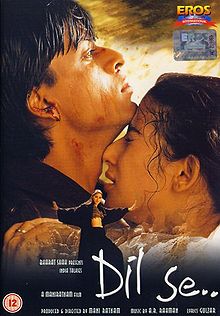
The engine that drives the plot of every Indian musical
is love. The plot is usually some variation of boy meets
girl, boy pursues girl but girl doesn't like boy, boy is
lured away by an evil temptress, first girl realizes her
love for boy and pursues boy, after a great struggle
sometimes involving danger and/or dancing, boy falls for
girl, they live happily ever after. Themes of intrigue,
revenge and jealousy dominate much of the action, sometimes
leading to scenes of melodrama (see below). Don't think for
a minute that because there's love in all Indian films that
you're going to see any sex because apparently it is
strictly forbidden. Often, the main characters will only
engage in a kiss on the cheek (could you imagine that
in an American film?) but there's no sweaty writhing bodies.
You never see a bare breast, but you will see lots of women
in very skimpy outfits dancing seductively, which is
infinitely more enticing.
Music
Where would romantic films be without the music montage?
Apparently, the montage has become the most common device to
show what characters are thinking about in Indian films.
Usually one or more of the scenes involve one character
fantasizing about how their life would be if they were
married to their romantic interest. These scenes are usually
stunningly beautiful with images of running through flowered
fields, standing atop high Himalayan pastures or dancing
around on a breathtaking beach. Songs are also used to
illustrate moral dilemmas, such as a choice between vice and
virtue, with loads of symbolism.
Comedy
There's usually some slapstick humor and bumbling or
wacky characters who pop up from time to time for a good
laugh, sometimes after a scene of heavy melodrama. Another
frequent theme is to have the two main characters bicker in
a humorous way when they first meet, before they eventually
realize their love for one another. Sometimes the songs are
comical as well, usually when one character is trying to woo
another one and performing a series of outlandish acts to
get the attention of the aloof woman or man.
English
Among the legacies of British colonial rule in India are
the sport of cricket and a smattering of English words which
have worked their way into Indian conversation. During the
movies, sometimes you can catch a few words you will
understand like "please," "hello" and "excuse me," or even a
brief exchange entirely in English. In addition, the credits
are always in English for some reason. Even the titles of
the film, although composed of Hindi words, are spelled out
phonetically with English characters as well as appearing in
Hindi.
Melodrama
There are plenty of soap opera-esque scenes with dramatic
music and unlikely plot twists (people who were thought to
be dead reveal that they have been alive under a new
identity, for instance). Music wells as the camera zooms in
on people's faces during tense moments. Arguments and
tearful reconciliations are plentiful, and always resovled
by the end of the film. Men are portrayed as quite emotional
in Indian films, often crying and hugging, but generally
standing around looking pouty.
Morality
In addition to the lack of sex, Bollywood films have a very
strong moral element. The evil characters, be they drug
dealers, thieves, drinkers or people who are mean to their
parents, usually get what's coming to them in the end. The
hero of the film, inevitably handsome, virtuous, modest and
hard-working, gets the girl and becomes materially and
spiritually fulfilled because he didn't succumb to wicked
temptations. That's not to say that the men are wimps-- an
important trait is for the man to be brave and strong in the
name of righteousness, perhaps beating up his foe, or
walking into a hail of bullets to save his love. Leading
women as well are beautiful paragons of virtue; shy, modest
and usually playing hard to get. In addition, traditional
family values must be incredibly important to Indian people
because strong families are usually central to the plot,
even in the more comic of films.
Going to a Bollywood Film
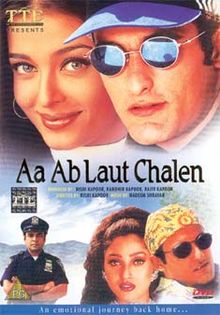
Seeing an Indian film isn't an easy thing for most
Americans to do. Indian-American people have a somewhat
isolated subculture, perhaps not as extreme as Chinese
people, but it is one that most Americans don't come into
contact with. Fortunately for us, there is a public
TV station in Philadelphia which broadcasts a whole day
of international programming every Sunday. It's all
incredibly fun to watch, from the Jamaican music videos to
the bizarre Korean game show, but far and away the most fun
comes from two shows, The
Asian Variety Show and Namaste America, which
focus almost exclusively on Bollywood, interviewing actors,
directors and singers in addition to showing clips from
current and old films. These shows are amazing.
During one of these shows a few months ago, there was a
commercial for a showing of an Indian film in a multiplex
theatre near our house, so we decided to see it. When we got
to the theater, we were planning on looking for the name in
the box office because we couldn't remember what it was
called (the title was in Hindi). The box office didn't have
the movie listed so we sheepishly approached the woman
behind the glass.
"Uh, is there an Indian movie playing here?"
"You buy your tickets in there," she replied, pointing to
a small table just inside the lobby of the theatre. "Do you
know the name of it?" she asked.
"No." Actually, we had a kind of vague notion that the
first word in the name was "Aa" or something like that.
We went inside where there was a small folding table with
a poster for the movie propped up next to it. A small group
of Indian people were buying tickets, and we walked up when
they were finished. The ticket seller looked at us oddly as
we bought the tickets, and when he noticed that Mary was
carrying a notebook (because she had been doing school work
in the car) he asked her if she had to see the movie for a
class.
"No," she said.
"Do you understand Hindi? There are no subtitles," the
man said.
"That's OK, we just like the music," I said.
They looked at us like we were insane, but they seemed to
admire us for wanting to see the film. "You will be able to
relate to this one because a lot of it was filmed in the
United States," he added, trying to encourage us.
We stood around in the lobby with the other people, not
quite knowing where to go. Finally a woman with a rubber
stamp came to rip the tickets we had just bought and to
stamp our hands with a butterfly. It was all very surreal as
we were the only non-Indian people in the crowd, and being
rather tall we kind of stood out.
After the stamping, we stood around in the lobby with the
group, waiting for some indication of which theater to go
into. None of the electronic signs which showed the names of
the films playing had the name of the Indian film, so we
just stood there awkwardly. Some of the people politely
engaged us in conversation, obviously quite curious about
why we would want to see a film in Hindi, so we had to keep
telling people that we really liked the music. They seemed
to understand this, and eventually we were led to a door
which had a sign above it reading She's All That. We
stood around while a group of bewildered teenagers streamed
out of the theater to find a crowd of sixty Indian people
and two confused non-Indian people waiting outside. The
marquee above the door really should have said:
Aa Ab Laut Chalen
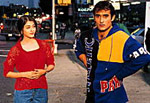
The theater was packed with everyone from very small children to
the elderly when the film finally started. The story is
rather complicated, but essentially it's about an unemployed
young man named Rohan living in India who is lured to New
York by his sleazy friend who has just returned to India
with riches from working in the US. Upon arrival in New
York, Rohan is disgusted to discover that his friend is a
pimp who runs a sleazy motel. If one was still undecided
about the moral fibre of the pimp, they show him forcing his
elderly parents to work as a maid and busboy at the motel,
and he is very mean to them. Rohan stays in New York, works
a series of odd jobs, and meets a woman named Pooja. This is
about the first hour of the film. At first, we weren't sure
it was really a musical, because, well, there hadn't been
any music. Suddenly, during a scene where the characters are
sitting in a park facing Manhattan, Rohan jumps up on a
table and starts singing. Dozens of brightly dressed
drummers appear out of nowhere and the whole thing goes
apeshit for about fifteen minutes. Eventually the plot
develops into a competition for Rohan's love between Pooja
and an evil temptress, in addition to several
family-unity-oriented subplots involving relatives of the
main characters.
The cinematography is breathtaking, with a great deal of
attention paid to the feeling of the scenes. Everything is
perfect in the stunning musical numbers, where the
characters belt out Hindi songs amid stunned passers-by in
various locations around New York City, including the
memorable Times Square scene. Even without understanding any
of the words (except for the American characters, who
weren't portrayed in a very favorable light) we understood
most of the plot and fully enjoyed the movie. We didn't even
realize that it was three hours long until we left the
theater, still in awe.
Indian Films on Video
Since Mary and I enjoyed the movie so much, I decided to
buy her a few Indian movies on video as a gift for
Valentine's Day. I went to a few mega-video stores, but
nobody had Indian musicals. Then, one Sunday during
Namaste America, I saw an ad for a grocery store
which sold "CDs, Sarees and Videos," so I went to check it
out. I found the store and went inside. There were videos
and CDs everywhere. I approached the clerk and said, "I'd
like to buy some Indian movies."
"Would you like anything in particular?" he said, looking
at the racks of hundreds of tapes.
"Well, what do you suggest? I think we'd like one with a
lot of music in it."
He pulled out a tape without a case, obviously a bootleg,
which said Dil Se.. on the side.
"How much are they?" I asked, preparing to pay $30.
"They are $2."
"To rent?" I asked, thinking this could be the only
explanation for this price.
"To buy!" he replied.
"Great! I'll take a few more also. Whatever you suggest.
They're for my wife. She loves Indian movies," I said,
thinking this would keep them from asking why I wanted to
buy them. I also picked up some excellent vindaloo
paste.
Needless to say the quality isn't the greatest, but you
still get the flavor of the movies even on the small screen.
Most of them seem to be "letterboxed" with black bands at
the top and bottom of the screen, further reducing the
viewing area, but the cinematography is still stunning.
Dil Se..

This was the first of them that we watched (part of the
frustration we feel is not being able to translate the
title). The plot centers around a reporter for Indian radio
who goes to the northern part of India to interview some
terrorists. In a train station on the way, he meets a
mysterious woman who leaves suddenly on the next train that
pulls in. He watches the train roll away, and suddenly it
turns into a huge musical number. This one is truly
astonishing-- the entire thing takes place on top of a
moving train rolling through soaring mountains and valleys.
I can only guess how many of the dancers were injured when
they took a wrong step and fell from the car.
The movie is great, with the mysterious woman seeming to
appear wherever they reporter goes to research a terrorist
incident. He becomes obsessed with her, but she won't have
anything to do with him (because obviously she's really a
terrorist). Although I can't comment on the dialogue, I can
say that the film is a marvel of cinematography, with
locations that have to be seen to be believed. The ending is
astounding as well.
Pyaar Kiya To Darna Kya

This
one was a kind of lighthearted romantic film with all the
great ingredients, but light on the melodrama. We were
utterly confounded by the plot, but after reading a review
in the Planet
Bollywood website, I can safely say that all of our
assumptions about the relationships of the characters were
completely wrong. Essentially, it's about a woman named
Muskaan who has an overprotective brother (we thought it was
her husband). She goes to a university, and a kind of silly,
bumbling guy named Suraj falls for her. Of course, the
brother will have none of it and does everything he can to
prevent them from being together, from dragging Suraj around
behind a horse to beating the crap out of him.
It's a pretty funny film, and some of the musical scenes
are fantastic, despite the fact that they are sparsely
scattered around the film. One really great number has Suraj
dancing around with his backpack, pretending it's Muskaan,
hugging and kissing it to the amusement of passers-by. This
film is worth watching just to see Suraj try to cook dinner
for Muskaan's family by himself.
Pyaar To Hona Hi Tha
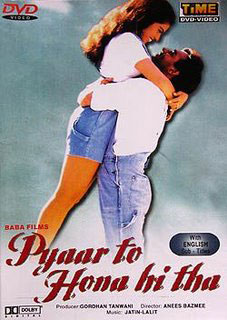
According to the review of this movie on the Planet
Bollywood website, this movie is an Indian remake of the
American film French Kiss which starred Kevin Kline
and Meg Ryan. Since I've never seen French Kiss, I
had to take their word for it. Essentially it's about a
woman named Sanjana whose boyfriend runs off with another
woman. She goes after him and meets Shekhar on the plane.
Shekhar is a thief who has stolen a valuable piece of
jewelry, which he hides in Sanjana's bag to avoid it being
found by a policeman who shows up at the airport to question
him. Eventually they show up at a beach resort to make the
former boyfriend jealous. As usual, there are some great
songs during the plot development, including a lavish one
where Shekhar sneaks off to rifle through Sanjana's bag
looking for the necklace. There's also a great one at the
beach resort with Sanjana teasing her ex-boyfriend and his
new woman in hilariously wicked ways.
The End
Indian films certainly aren't for everyone, but we think
that they're loads of fun. There's lots to love in the campy
world of Bollywood: incredible cinematography, wacky
slapstick humor, tear-jerking melodrama, romance, great
music and of course, outrageous musical numbers that leave
you wanting more.






























